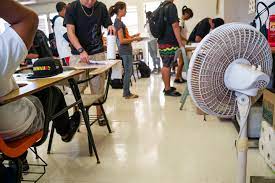Introduction:
Sweltering temperatures in classrooms across the globe have become a pressing issue for students and educators alike. As climate change continues to cause extreme weather patterns, schools are struggling to maintain an optimal learning environment for their pupils. The impact of high classroom temperatures on student performance, health, and overall well-being cannot be ignored. In this article, we will explore how rising temperatures are affecting schools and discuss potential solutions to ensure a comfortable and productive educational experience.
The Impact on Student Performance:
Numerous studies have confirmed the negative effects of extreme heat on cognitive function and student performance. High classroom temperatures have been linked to decreased concentration, slower information processing, impaired memory retention, and reduced problem-solving abilities. Uncomfortable learning environments diminish students’ capacity to engage with academic material, making it more challenging for educators to facilitate impactful lessons.
Health Implications:
In addition to impacting academic performance, excessively hot temperatures can also lead to various health issues among students. Classroom temps above 90°F can cause dehydration, heat exhaustion, and heatstroke – posing severe risks to children’s health. Moreover, warmer conditions increase the likelihood of mold growth and poor indoor air quality in schools, exacerbating allergy symptoms and respiratory problems among vulnerable students.
Socioeconomic Disparities:
Unfortunately, the reality is that not all schools have access to adequate air conditioning systems or the resources needed for effective thermal management. Often, it is economically disadvantaged schools that suffer most from sweltering classroom conditions. These disparities further contribute to unequal educational outcomes as lower-income children are disproportionately affected by oppressive classroom environments.
Potential Solutions:
Addressing the issue of excessive classroom heat requires comprehensive and holistic strategies as well as innovative thinking from policymakers. Potential solutions include:
1) Retrofitting existing school buildings with energy-efficient cooling systems
2) Implementing green infrastructure initiatives such as rooftop gardens or shading elements
3) Employing passive cooling techniques, like natural ventilation and improved insulation
4) Encouraging schools to provide regular water breaks and resting areas to avoid dehydration and overexertion
5) Establishing guidelines for heat days to ensure appropriate measures are in place when temperatures rise
Conclusion:
As we face a future defined by increasingly sweltering temperatures, it is essential that educators, administrators, and policymakers alike prioritize the creation and maintenance of comfortable learning environments for our students. By investing in sustainable cooling solutions and adopting proactive strategies for managing classroom temperatures, we can ensure our schools remain fertile grounds for education and growth. The health, safety, and academic success of the next generation depend on it.





